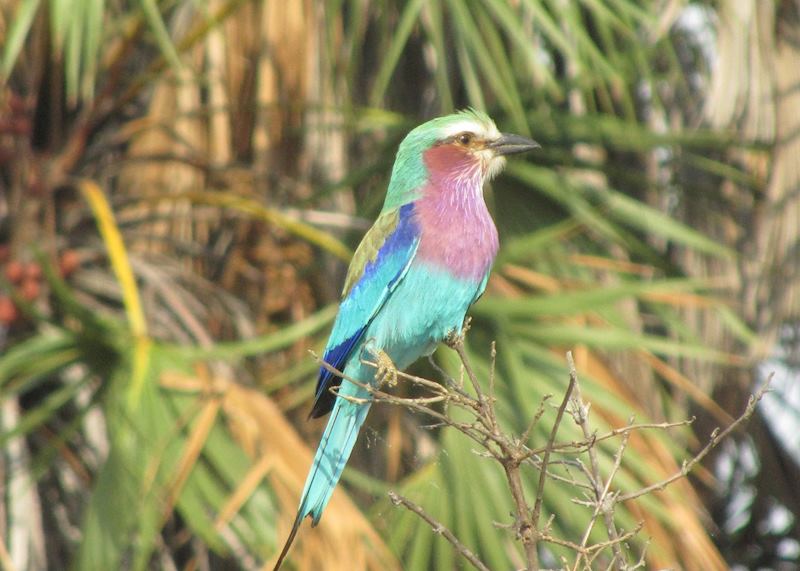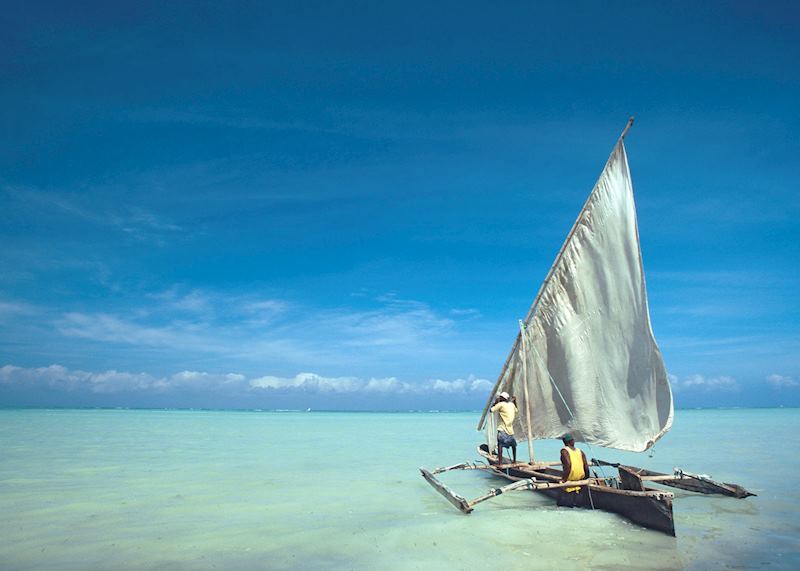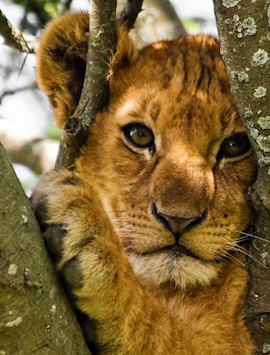By Africa specialist Sean
Rightly famed for its wildlife, Tanzania has some of the best safari experiences I've encountered. But, don't be misled into thinking it's just about big game spotting and grassy plains. Tanzania is a very versatile honeymoon option.
A place where you could hike to the edge of the vast Ngorongoro Crater or end your trip lazing by your private pool on Zanzibar Island. Take a boat ride through the wetlands of the Nyerere National Park or dive off the coast from close-lying Mafia Island. Whichever you decide, it's possible to find a secluded spot to do it.
Find a quiet corner of the Serengeti


In the Maasai language, Serengeti means ‘never ending landscape’. As you travel through the vast plains that stretch up to Tanzania's border with Kenya, it's easy to see why. The Serengeti is arguably one of the best-known parks in Africa, but don't be dissuaded by its popularity.
The open grassland stretches for hundreds of miles, dotted with the occasional kopje, a rocky outcrop, where it's often possible to see cheetah scouting the horizon.
I'd suggest heading to the quieter north of the park. As you drive, the landscape becomes rockier and more rolling, broken up by the occasional river or lake.
On safari here you'll see very few other jeeps during the day. I sat for hours quietly watching a pride of lion, completely uninterrupted.
Camps are scattered over a wide area, my first choice being Sayari Camp, which overlooks the Mara River. Sayari is a little different to the regular khaki tents, with its furnishings more akin to a boutique hotel. Sliding glass doors along one side of the tent give you the indulgence of lying in bed while watching the wildlife unfold in front of you. I was woken one morning to the racket of two hippo fighting nearby.
Explore the Ngorongoro Crater


The explosion and collapse of a volcano some two to three million years ago created the gaping 30 km (19 mile) diameter Ngorongoro Crater. Now carpeted in grassland, its 600 m (1,968 ft) high walls protect an independent ecosystem within. This natural sanctuary supports a large concentration of mammals.
I first saw the crater by driving up to a viewpoint on its rim, from where you can peer down the sheer drop to its floor and pick out the light reflecting off one of the rivers that gently meanders through the middle.
It's possible to see the herds of impala moving around below you, and you should be able to spot black rhino or hyena. Elsewhere in Tanzania, spotting rhino can be difficult but you've a much better chance in the Ngorongoro Crater due to the high concentration of them here.
I'd recommend staying nearby at Gibb's Farm in the Ngorongoro Highlands. Built into the side of a hill, the stone walled cottages are scattered through the plush gardens with views down into the valley.
From Gibb's Farm, you can walk to the edge of the crater, a relatively strenuous walk of four to six hours. Your guide can bring along a picnic for you to enjoy while you gaze down into the crater.
Stay at isolated safari camps in Tarangire


To the southeast of the Ngorongoro Crater lies Tarangire National Park. I'm particularly fond of this park as game sightings are so reliable. It's best to visit in the dry season, from June to September, as thousands of thirsty animals travel from the surrounding areas to drink in the Tarangire River.
Little Oliver's Camp, my recommended accommodation, only has 12 tents — it's worth requesting the one set away from everyone else. In the heat of midday I unzipped my canvas tent flap and lay, protected by my mosquito net, watching an elephant and a group of wildebeest ambling around in front of me.
With high ceilings, huge wooden framed beds and luxurious bathrooms, the tents are simply designed but comfortable. The camp is designed to maximise your chances of spotting the wildlife: even the outdoor shower has one wall lowered so you can see the plains while you wash.
You will need to radio out to leave your tent. A leopard was roaming through the camp when I wanted to leave for lunch one afternoon. A ranger will come and scoop you up in his jeep.
Game drives in Tarangire helped me to appreciate the vast numbers of wildlife that live here. One day, we encountered a pride of lion, the cubs rolling around in the dust. The pride had gathered below a leopard stuck high in a tree. The friction between the trapped leopard and the lion protecting their vulnerable cubs could be felt in the air.
Float down the river in Nyerere National Park

Nyerere National Park is Africa's largest national park. Despite its size, it has always been eclipsed by the more well-known Serengeti, and so it benefits from far fewer visitors.
It's a short flight south from Dar es Salaam to Nyerere National Park — an experience in itself. The views from the tiny plane are only usually seen on wildlife documentaries.
With the Rufiji River snaking through the reserve's woods and grassland, you can take the opportunity to explore by boat. Hippo and crocodiles are easy to spot, as are the numerous bird species such as the white-headed vulture and the orange-beaked African skimmer. There's also the opportunity to spot the rare Pel鈥檚 fishing owl.
I'd suggest taking drinks on board to enjoy a sundowner at dusk. When the driver kills the boat's engine, you can gently bob down the river listening to the wildlife.


Safari camps aren't always luxurious, and Lake Manze Camp, on the shores of its namesake, is a rustic option. With no electricity or phone signal, and bucket showers and canvas tents, it's a true back-to-basics experience. The 12 tents are well spaced with private verandas, some of which overlook a well-trodden elephant corridor on the edge of the camp.
Extending your honeymoon in Tanzania
The exotic spice trader islands along Tanzania's east coast make a satisfying end to a busy honeymoon, with easy connections from Dar es Salaam's airport.
Relax on Zanzibar


For me, just the name Zanzibar is enough to suggest mystery. The myriad of winding passageways and buildings of Stone Town and its trading ancestry, together with palm fringed beaches fit this reputation well.
I'd recommend Zanzibar for active honeymooning couples who want to enjoy coastal scenery but still find plenty of other ways to explore. Wandering through the old slaving port of Stone Town, you can see the fragrant spice markets and spot former sultans’ abodes hidden behind imposing carved doors. If you haven't been saturated with wildlife sightings already, you can go to the Jozani Forest to see the colobus monkeys — black faced with crowns of white fur — darting around.
A good way to escape fellow visitors is to shut yourselves away in a spacious villa. Baraza, on the west coast of the island, has just 30 villas, each with its own private plunge pool and sumptuous day beds.
Discover the lesser known beaches of the Mafia Islands


Lying to the south of Zanzibar, the Mafia Archipelago is a relatively unknown string of tiny islands. I can genuinely call the beaches, flanked with tangled mangroves, unspoilt.
Other than wandering the deserted beaches, you can dive in the Rufiji Mafia Kilwa Marine Reserve, home to unspoilt reefs, rays and the occasional turtle. Visit between October and March and you might spot a whale shark.
The accommodation options offer a more authentic, rustic feel than Zanzibar. You can stay in one of only seven stilted bungalows at Pole Pole Bungalows on Mafia, the main island. Each is nestled away among the palm trees and furnished with traditionally carved beds and locally made raffia furnishings.
Best time to honeymoon in Tanzania
It's possible to travel to Tanzania most of the year, avoiding the heavy rains from the end of March through to May. Due to the ever evolving scenery and animal migration, each month has something different to offer.
June is a cost-effective time to travel, as it's the beginning of the season when hotel prices are lower and visitors are fewer. I'd recommend honeymooning in the driest months of July to September for the best wildlife sightings, as the grasses have died back and the limited water supply means the animals' movements tend to be more predictable.
Start planning your honeymoon to Tanzania
Start thinking about your experience. These itineraries are simply suggestions for how you could enjoy some of the same experiences as our specialists. They're just for inspiration, because your trip will be created around your particular tastes.
View All Tours in Tanzania



